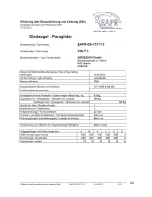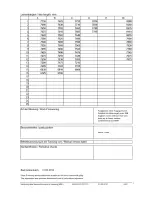
29
l.
Negative spin
We recommend that this manoeuvre is only carried out during a safety training course over
water and under supervision. The intention in this situation is for a pilot to discover the point-
of-spin and to control it. This demands a high level of experience and skill.
The longer the time between the glider entering a spin and the pilot attempting to recover, the
more chance there is of it becoming out of control.
As the glider surges forward slow it down with the brakes to avoid the possibility of an
asymmetric collapse. Always wait for the glider to be in front of you or above you when
releasing a fully deployed spin - never release the spin while the wing is behind you because
the glider would dive very far in front of you or even underneath.
m.
Full-stall
This is an extreme manoeuvre that should rarely, if ever, be required.
To induce a full stall, pull both brake-lines down smoothly. Hold them down, locking your arms
under your seat until the canopy falls behind you and deforms into a characteristic crescent
shape. In spite of how uncomfortable it may feel as the glider falls backwards, be careful not to
release the brakes prematurely or asymmetrically. If the brakes are released while the glider is
falling backwards the surge and dive forwards is very fast and the glider may shoot in front and
even underneath you.
In a full stall the canopy will oscillate back and forth. To stabilise this, the pilot can release the
brakes slowly and for approximately 1/3 of the brake travel and then hold at this level. Holding
at this position allows the wing to refill slightly across the span. When releasing the brakes
without pre-filling the ears mostly will most probably hook in the lines and this can result in a
cravat.
After pre-filling the glider stabilizes its movements and the brakes can be leased until the glider
recovers speed and flies again.
ATTENTION: The full stall requires a lot of height and demands certain skills to recover. It is
important this manoeuvre is not practiced without qualified supervision.
It should preferably be practiced during a safety training course.
n.
Rapid decent manoeuvres
i.
Spiral
The spiral dive is an effective way of making a fast descent. During the spiral dive the pilot and
glider will experience strong centrifugal forces which strain the glider. As such it should be
considered an extreme manoeuvre. Due to the rapid height loss during a spiral, pilots must
always take care that they have sufficient altitude before initiating the manoeuvre and that the
airspace is free around the pilot.
Initiation
: Weight shift and smoothly pull on one brake (the same side you are weight shifting
into) so the glider goes from a normal 360-degree turn into a steep turn and from there into a
spiral dive. Once established in the spiral the descent rate and bank angle can be controlled
with weight shift and the releasing or pulling of inner brake. As the glider banks in front of the
pilot maintain the spiral by keeping the brake pressure constant, at this point weight-shift can
be neutralised. Descent is controlled by pulling more on the inner brake. A slight pull on the
outside brake helps to keep the glider stable.
Summary of Contents for Volt
Page 20: ...36 A ANHANG ANNEX a Übersichtszeichnung Overview ...
Page 21: ...37 b Leinenplan line plan ...
Page 22: ...38 ...
Page 25: ...41 C EBL DDP ...
Page 26: ...42 ...
Page 27: ...43 ...
Page 28: ...44 ...
Page 29: ...45 ...
Page 34: ......














































